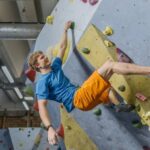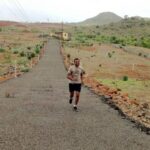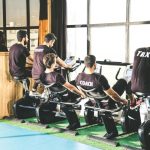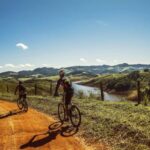Endurance training is a critical aspect of climbing that allows climbers to sustain physical efforts over extended periods. Effective endurance training targets key muscle groups such as fingers, forearms, biceps, legs, and core, enabling climbers to maintain balance and grip on challenging terrains. Properly structured endurance training enhances a climber’s ability to perform consistently and efficiently on longer routes without succumbing to fatigue.
Climbers often use various methods to build their endurance, such as ARC (Aerobic Restoration and Capillarity) training, which involves staying on the wall for extended periods while performing easy moves. Mixing up the routine with technique drills, like practicing drop-knees, can help maintain engagement and improve specific skills. Interval training, where climbers perform one-minute intervals at an intensity just below their maximum, is another effective approach.
A well-rounded endurance training plan involves integrating both high-intensity sessions and lower-intensity, longer-duration workouts. Organizing training days with a balanced ratio and incorporating recovery weeks ensures steady progress and reduces the risk of injury. By consistently working on endurance, climbers can achieve a higher level of performance and tackle more demanding climbs.
Understanding Endurance in Climbing
Endurance in climbing involves a mixture of muscular endurance, energy system efficiency, and aerobic capacity. These elements work together to help climbers sustain their effort on challenging routes.
Types of Endurance
Muscular Endurance
In climbing, endurance isn’t just about overall stamina; it’s about the ability of specific muscle groups to perform repeated contractions over time. Fingers, forearms, biceps, legs, and core are all heavily involved in maintaining grip and balance. This type of endurance allows climbers to hang on for longer periods, particularly important during sustained climbs.
Anaerobic Endurance
Anaerobic endurance is crucial for short bursts of intense effort. It’s about how well muscles can perform in the absence of oxygen, relying on the body’s ability to break down glycogen quickly. This is often essential in bouldering or difficult sections of climbs where one needs maximum power in a short time.
Energy Systems and Muscle Fibers
Understanding ATP Production
The body’s energy systems play a vital role. Adenosine Triphosphate (ATP) is the primary energy currency of the cell, crucial for muscle contractions. During climbing, the ATP-PC system, glycolysis, and oxidative phosphorylation are all engaged to various extents, depending on the intensity and duration of the climb.
Role of Muscle Fibers
Climbing leverages different muscle fibers: type I (slow-twitch) and type II (fast-twitch). Slow-twitch fibers are endurance-oriented and efficient at using oxygen to generate ATP. Conversely, fast-twitch fibers are more powerful but fatigue faster. Training aims to balance these fibers to enhance endurance without sacrificing power.
The Role of Aerobic Capacity
Capillaries and Oxygen Supply
Aerobic capacity is central to endurance. It determines how effectively the cardiovascular system can deliver oxygen to muscles. Capillaries, the smallest blood vessels, play a crucial role in this, improving the muscles’ ability to sustain prolonged activity by ensuring a steady oxygen supply and facilitating the removal of waste products like lactic acid.
Cardiovascular Fitness
Improving cardiovascular fitness enhances the efficiency of the heart and lungs. This not only boosts overall aerobic capacity but also helps in quicker recovery during rest phases on the climb. Climbers often engage in cross-training activities such as running, cycling, or swimming to boost their cardiovascular fitness, benefiting their climbing endurance.
Essential Climbing Training Principles
Climbing endurance training encompasses several key principles, including balancing intensity and volume, ensuring proper rest and recovery, and following a structured progression and conditioning plan.
Training Intensity and Volume
Balancing training intensity and volume is critical for climbers seeking to build endurance. Intensity refers to how hard a climber works during their sessions, while volume involves the total amount of climbing or specific exercises performed.
High-intensity workouts develop strength and power. For endurance, lower intensities with higher volumes ensure sustained effort. For instance, performing routes with moderate difficulty repeatedly can increase endurance without overtaxing the muscles.
Climbers might follow a 3:1 ratio during specific phases, such as focusing on strength three times a week and endurance once. This balance helps optimize training outcomes without causing burnout.
Rest and Recovery
Rest and recovery are crucial for maintaining peak performance and avoiding injuries.
Training schedules should include rest days to allow muscles to repair and grow. Typically, climbers may train for 2-3 days, followed by a rest day. Recovery weeks every 2-3 months help reset the body.
Hydration and nutrition play important roles in recovery. Consuming a balanced diet with carbohydrates and protein aids muscle repair. Staying adequately hydrated, particularly before and after climbing sessions, is essential to prevent fatigue.
Progression and Conditioning
Progression and conditioning ensure that climbers continually improve without plateauing.
Progressively increasing the difficulty of routes or the duration of training sessions prevents the body from adapting too easily. For example, climbers might start with easier routes and gradually move to more challenging ones, advancing in small increments.
Incorporating a variety of training methods like ARC (Aerobic Restoration and Capillarity) training, technique drills, and strength exercises ensures comprehensive conditioning.
By engaging various muscle groups—such as fingers, forearms, biceps, legs, and core—through targeted exercises, climbers can build a well-rounded fitness base that supports improved endurance and overall performance.
Climbing-Specific Endurance Workouts
Developing climbing-specific endurance involves a combination of interval training, continuous climbing sessions, and circuit training. These methods focus on improving the ability to sustain effort over time, essential for success on longer routes and challenges.
Interval Training
Interval training involves periods of high-intensity climbing alternated with rest. One popular format is the 4×4 routine, where the climber completes four routes in a row with minimal rest, then repeats this set four times.
Intervals can be tailored to individual fitness levels by adjusting route difficulty and rest time. Benefits include improved muscle endurance and recovery due to repeated stress and recovery cycles. This method is effective for building stamina and simulating the stop-and-go nature of challenging climbs.
Continuous Climbing Sessions
Continuous climbing sessions focus on maintaining sustained activity for extended periods. These workouts often incorporate ARC (Aerobic Restoration and Capillarity) training, where climbers stay on the wall for 20-30 minutes without resting.
This type of session aims to build capillarity in the forearms, allowing muscles to work longer without fatigue. Traversing or connecting multiple routes without breaks helps enhance local endurance and mental focus, critical for long climbing sessions.
Circuit Training
Circuit training in climbing involves completing a sequence of different routes or exercises with minimal rest in between. This can be designed as a circuit of six to eight routes, each targeting various muscle groups and technical skills.
For example, the climber might include overhangs, slabs, and vertical walls in one circuit. This approach helps in building comprehensive endurance and technical versatility. Additionally, incorporating strength exercises between climbing routes can further enhance muscle endurance and power.
By including these climbing-specific endurance workouts in their training regimen, climbers can significantly improve their capacity to tackle longer and more demanding routes.
Building a Foundation: Physical and Technical Training
Developing a strong foundation in climbing endurance requires integrating specific types of physical and technical training. Key areas include enhancing strength and power, improving technique and mobility, and ensuring the body remains flexible with balanced antagonistic muscle development.
Strength and Power Training
Strength and power training forms the backbone of an effective climbing regimen. It focuses on building maximum strength, particularly through exercises like hangboarding, weighted pull-ups, and campus board training. Climbers should also incorporate bouldering sessions to develop explosive power crucial for short, intense climbing sequences.
For example, hangboarding involves holding various grips for set durations. Typically, this might mean hanging for 7 seconds, resting for 3 seconds, and repeating several times. Weighted pull-ups can be performed with added resistance progressively increased over time to build upper body and grip strength.
Technique and Mobility Drills
Proper technique and mobility are essential for efficient climbing. Drills that focus on precise foot placement, maintaining body tension, and fluid movement are important.
Footwork drills can help climbers place their feet accurately and use the least amount of energy to move upward. Flagging and drop knees are techniques that can be practiced on easier routes to improve balance and conserve energy. Mobility exercises, such as hip openers and shoulder stretches, allow climbers to reach holds more easily and maintain good form.
Flexibility and Antagonist Exercises
Flexibility and antagonist muscle training prevent injuries and ensure muscular balance. Stretching routines targeting the major muscle groups used in climbing, such as the forearms, shoulders, and hips, improve flexibility.
Antagonist exercises, like reverse wrist curls for the forearms and push-ups for the chest, are crucial. They counteract the muscle imbalances caused by the repetitive pulling actions in climbing. Keeping flexibility and antagonistic strength in check reduces the risk of overuse injuries and ensures longevity in the sport.
By structuring training to cover these areas, climbers can build a solid foundation that supports both endurance and overall climbing performance. Adjusting training plans to meet individual needs and progress levels is key to long-term improvement and injury prevention.
Training for Specific Climbing Scenarios
Endurance training in climbing varies based on the type of climb, requiring different focuses for bouldering, sport climbing, and multi-pitch climbing. Each scenario necessitates distinct training techniques to build the necessary endurance and strength.
Bouldering and Power-Endurance
Bouldering emphasizes short, powerful bursts of strength and requires power-endurance to tackle sequences of intense moves. Training involves repetitive high-intensity exercises, such as 4x4s (four problems climbed four times) and campus board workouts. These exercises aim to increase muscle stamina and explosive power.
Climbers should also incorporate interval training to enhance anaerobic capacity. This involves performing short, high-effort climbs with brief rests. Maintaining a varied routine helps prevent plateauing and keeps the training sessions engaging.
Sport Climbing and Local Endurance
Sport climbing demands sustained physical efforts over longer routes, focusing on local endurance. ARC (Aerobic Restoration and Capillarity) training is effective in building this type of endurance. ARC sessions typically involve nonstop climbing on easy routes for 20-40 minutes to enhance capillary density and forearm endurance.
In addition to ARC training, incorporating technique drills like drop-knees and flagging can improve efficiency and reduce fatigue. Climbers should also integrate days of strength training to maintain a balance between power and endurance.
Multi-Pitch and Onsight Climbing
Multi-pitch and onsight climbing require climbers to handle several pitches consecutively with minimal rest. These scenarios emphasize both local endurance and overall aerobic endurance. Training involves linking multiple routes or practicing on long top-rope laps to simulate the continuous climbing experience.
Onsight climbers benefit from mental endurance training, which includes visualizing climbs and practicing route reading. Additionally, cross-training activities like running or cycling help build general aerobic capacity crucial for maintaining stamina over extended periods.
For both multi-pitch and onsight climbing, rest and recovery are crucial. Climbers should schedule recovery weeks every two to three months to prevent burnout and promote muscle recovery.
Devising Your Personalized Climbing Training Plan
To create an effective climbing training plan, it’s crucial to evaluate your current fitness and climbing performance, establish clear and achievable goals, and find a balance between training and actual climbing practice.
Assessing Your Climbing and Fitness Level
Begin by determining your current climbing abilities and fitness levels. Consider factors like your onsight level, strength, endurance, and climbing-specific skills.
You can start by noting down your best performances in terms of routes or boulder problems completed.
A fitness assessment can include evaluating general conditioning, flexibility, and key muscle groups’ strength. Use this information to identify areas needing improvement.
Setting Appropriate Goals
Setting specific and measurable goals is essential for progress. Break down your long-term objectives into achievable short-term goals.
For example, if your aim is to improve your onsight level, create steps such as:
- Increasing finger strength.
- Enhancing overall endurance.
Ensure goals are realistic and align with your current ability. Write them down and track progress regularly to stay motivated.
Balancing Training with Climbing
A successful training plan should harmonize actual climbing with strength and endurance exercises. Specificity is key; incorporate exercises like deadhangs, pull-ups, and leg raises on a portable hangboard.
Plan your week to balance training days and climbing days to avoid overtraining and injuries. For instance:
Monday: Strength training Wednesday: Climbing practice Friday: Endurance training
This separation helps maintain high quality in both training and climbing sessions, ensuring continuous improvement.
Optimizing Recovery and Nutrition for Climbing Endurance
Recovering effectively and maintaining optimal nutrition are pivotal for enhancing climbing endurance. Key strategies include specific recovery techniques, targeted nutritional practices, and appropriate supplementation.
Recovery Techniques
Effective recovery techniques help climbers restore energy and repair muscle tissue. Active recovery, like light stretching or yoga, enhances blood flow and reduces muscle stiffness. Passive techniques, such as sufficient sleep and massage therapy, are critical for muscle repair and overall well-being.
Cold water immersion or ice baths can reduce inflammation and muscle soreness. Similarly, contrast baths (alternating hot and cold water) improve circulation and expedite tissue recovery. Regularly incorporating rest days ensures muscles have time to rebuild and strengthen.
Nutritional Strategies
Nutrition fuels climbing performance and endurance. Prioritize complex carbohydrates, like oats and quinoa, for sustained energy. Proteins from sources such as lean meats, dairy, and legumes aid in muscle repair and growth. Healthy fats from nuts, seeds, and avocados support hormone production and cell function.
Hydrate adequately before, during, and after climbs. Electrolyte drinks can replenish lost minerals after strenuous activity. Timing is crucial: consuming a meal rich in carbs and proteins about 2-3 hours before climbing can optimize energy stores. Post-climb, refuel with a balanced snack within 30 minutes to restore glycogen levels and kick-start muscle recovery.
Supplementation
Supplementation can complement a balanced diet to enhance endurance and recovery. Protein powders provide a convenient way to meet daily protein needs, especially post-exercise. Branched-chain amino acids (BCAAs) can reduce muscle soreness and enhance recovery.
Creatine supplements might boost high-intensity performance, beneficial for repeated climbing efforts. Electrolyte supplements help maintain hydration levels and replace minerals lost through sweat. Caffeine, taken in moderate doses, can enhance focus and reduce perceived exertion.
Always consult a healthcare professional before starting any supplementation to tailor the choices to individual needs and avoid potential adverse effects.
The Mental Game: Building Resilience and Focus
Developing mental resilience and focus is critical in climbing. Emphasizing psychological conditioning, effective pacing and breathing techniques, and overcoming mental barriers can enhance performance and endurance.
Psychological Conditioning
Psychological conditioning is key to building mental resilience. Climbers can benefit from incorporating mindfulness practices such as meditation and visualization into their routine.
Visualization can involve picturing a successful climb, reinforcing confidence and readiness. Meditation aids in calming the mind and reducing anxiety, allowing for clear and focused decision-making while climbing.
Positive self-talk and mantras can also foster a growth mindset. Repeating affirmations can instill confidence and reinforce a climber’s inner strength, helping them to remain resilient under pressure.
Pacing and Breathing Techniques
Pacing and breathing are essential for maintaining control and focus during climbs. Using rhythmic breathing helps climbers manage stress and conserve energy efficiently.
Breathing Techniques:
- Deep, slow breaths to maintain calm.
- Exhalation during challenging moves to release tension.
Pacing:
- Climbing at a steady, controlled pace prevents premature fatigue.
- Incorporating rest points where climbers can shake out their muscles and regroup mentally.
Mindful climbing, which focuses on being present in each movement and grip, helps to align both mental and physical efforts.
Overcoming Mental Barriers
Confronting and overcoming mental barriers is crucial for achieving endurance in climbing. Fear of failure and the unknown often impede performance.
By gradually exposing themselves to more challenging climbs, climbers can build confidence and reduce fear. This approach, often referred to as exposure therapy, helps in acclimatizing to increasingly difficult scenarios.
Setting incremental goals and celebrating small victories reinforces positive experiences, promoting mental endurance. Each success strengthens a climber’s belief in their abilities and diminishes mental obstacles.
Regular reflection on past climbs, focusing on what went right and areas for improvement, enhances future performance by fostering a learning mindset. This iterative process contributes to sustained mental resilience and focus.








